
Personal protective equipment (PPE) is protective clothing, helmets, goggles, or other garments or equipment designed to protect the wearer's body from injury or infection. The hazards addressed by protective equipment include physical, electrical, heat, chemical, biohazards, and airborne particulate matter. Protective equipment may be worn for job-related occupational safety and health purposes, as well as for sports and other recreational activities. Protective clothing is applied to traditional categories of clothing, and protective gear applies to items such as pads, guards, shields, or masks, and others. PPE suits can be similar in appearance to a cleanroom suit.

A respirator is a device designed to protect the wearer from inhaling hazardous atmospheres including fumes, vapours, gases and particulate matter such as dusts and airborne pathogens such as viruses. There are two main categories of respirators: the air-purifying respirator, in which respirable air is obtained by filtering a contaminated atmosphere, and the air-supplied respirator, in which an alternate supply of breathable air is delivered. Within each category, different techniques are employed to reduce or eliminate noxious airborne contaminants.

Respiratory tract infections (RTIs) are infectious diseases involving the lower or upper respiratory tract. An infection of this type usually is further classified as an upper respiratory tract infection or a lower respiratory tract infection. Lower respiratory infections, such as pneumonia, tend to be far more severe than upper respiratory infections, such as the common cold.

Airborne transmission or aerosol transmission is transmission of an infectious disease through small particles suspended in the air. Infectious diseases capable of airborne transmission include many of considerable importance both in human and veterinary medicine. The relevant infectious agent may be viruses, bacteria, or fungi, and they may be spread through breathing, talking, coughing, sneezing, raising of dust, spraying of liquids, flushing toilets, or any activities which generate aerosol particles or droplets.

A neck gaiter or neck warmer is a neckwear, or an enlarged collar of a garment, that is worn around the neck for warmth. It is usually a closed tube of fabric, often thick fleece, merino wool, synthetic wicking, or knit material, which is slipped on and off over the head to cover the entire neck and conserve body heat. Some balaclavas are essentially a small hood attached to a neck gaiter. Like gaiters for the lower legs, a neck gaiter augments the protection offered by other garments.
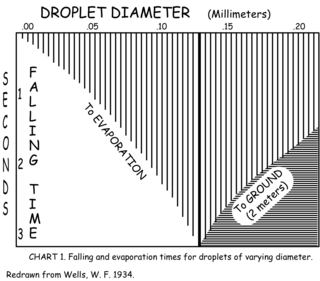
The Wells curve is a diagram, developed by W. F. Wells in 1934, which describes what is expected to happen to small droplets once they have been exhaled into air. Coughing, sneezing, and other violent exhalations produce high numbers of respiratory droplets derived from saliva and/or respiratory mucus, with sizes ranging from about 1 µm to 2 mm. Wells' insight was that such droplets would have two distinct fates, depending on their sizes. The interplay of gravity and evaporation means that droplets larger than a humidity-determined threshold size would fall to the ground due to gravity, while droplets smaller than this size would quickly evaporate, leaving a dry residue that drifts in the air. Since droplets from an infected person may contain infectious bacteria or viruses, these processes influence transmission of respiratory diseases.
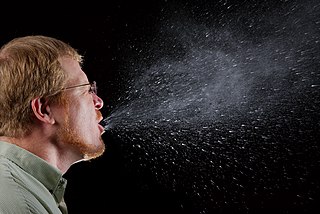
A respiratory droplet is a small aqueous droplet produced by exhalation, consisting of saliva or mucus and other matter derived from respiratory tract surfaces. Respiratory droplets are produced naturally as a result of breathing, speaking, sneezing, coughing, or vomiting, so they are always present in our breath, but speaking and coughing increase their number.

A respirator fit test checks whether a respirator properly fits the face of someone who wears it. The fitting characteristic of a respirator is the ability of the mask to separate a worker's respiratory system from ambient air.

The NIOSH air filtration rating is the U.S. National Institute for Occupational Safety and Health (NIOSH)'s classification of filtering respirators. The ratings describe the ability of the device to protect the wearer from solid and liquid particulates in the air. The certification and approval process for respiratory protective devices is governed by Part 84 of Title 42 of the Code of Federal Regulations. Respiratory protective devices so classified include air-purifying respirators (APR) such as filtering facepiece respirators and chemical protective cartridges that have incorporated particulate filter elements.
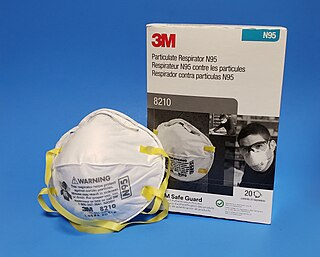
An N95 respirator is a particulate-filtering facepiece respirator or elastomeric filter that meets the U.S. National Institute for Occupational Safety and Health (NIOSH) N95 classification of air filtration, meaning that it filters at least 95% of airborne particles that have a mass median aerodynamic diameter of 0.3 micrometers under 42 CFR Part 84. This standard does not require that the respirator be resistant to oil; two other standards, R95 and P95, add that requirement. The N95 type is the most common particulate-filtering facepiece respirator. It is an example of a mechanical filter respirator, which provides protection against particulates but not against gases or vapors. An authentic N95 respirator is marked with the text "NIOSH" or the NIOSH logo, the filter class ("N95"), and, for filtering facepiece respirators, a "TC" approval number of the form XXX-XXXX, the approval number. All N95 respirators, regardless of type, must be listed on the NIOSH Certified Equipment List (CEL) or the NIOSH Trusted-Source page, and it must have headbands instead of ear loops.

Hazard controls for COVID-19 in workplaces are the application of occupational safety and health methodologies for hazard controls to the prevention of COVID-19. Vaccination is the most effective way to protect against severe illness or death from COVID-19. Multiple layers of controls are recommended, including measures such as remote work and flextime, increased ventilation, personal protective equipment (PPE) and face coverings, social distancing, and enhanced cleaning programs.

A cloth face mask is a mask made of common textiles, usually cotton, worn over the mouth and nose. When more effective masks are not available, and when physical distancing is impossible, cloth face masks are recommended by public health agencies for disease "source control" in epidemic situations to protect others from virus laden droplets in infected mask wearers' breath, coughs, and sneezes. Because they are less effective than N95 masks, surgical masks, or physical distancing in protecting the wearer against viruses, they are not considered to be personal protective equipment by public health agencies. They are used by the general public in household and community settings as protection against both infectious diseases and particulate air pollution.
An aerosol-generating procedure (AGP) is a medical or health-care procedure that a public health agency such as the World Health Organization or the United States Centers for Disease Control and Prevention (CDC) has designated as creating an increased risk of transmission of an aerosol borne contagious disease, such as COVID-19. The presumption is that the risk of transmission of the contagious disease from a patient having an AGP performed on them is higher than for a patient who is not having an AGP performed upon them. This then informs decisions on infection control, such as what personal protective equipment (PPE) is required by a healthcare worker performing the medical procedure, or what PPE healthcare workers are allowed to use.

Mechanical filters are a class of filter for air-purifying respirators that mechanically stops particulates from reaching the wearer's nose and mouth. They come in multiple physical forms.
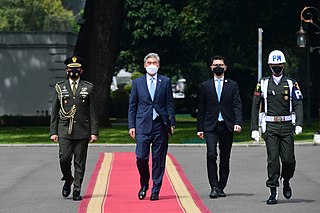
During the COVID-19 pandemic, face masks or coverings, including N95, FFP2, surgical, and cloth masks, have been employed as public and personal health control measures against the spread of SARS-CoV-2, the virus that causes COVID-19.

Source control is a strategy for reducing disease transmission by blocking respiratory secretions produced through speaking, coughing, sneezing or singing. Surgical masks are commonly used for this purpose, with cloth face masks recommended for use by the public only in epidemic situations when there are shortages of surgical masks. In addition, respiratory etiquette such as covering the mouth and nose with a tissue when coughing can be considered source control. In diseases transmitted by droplets or aerosols, understanding air flow, particle and aerosol transport may lead to rational infrastructural source control measures that minimize exposure of susceptible persons.
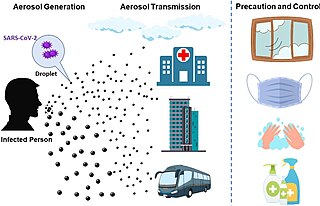
The transmission of COVID-19 is the passing of coronavirus disease 2019 from person to person. COVID-19 is mainly transmitted when people breathe in air contaminated by droplets/aerosols and small airborne particles containing the virus. Infected people exhale those particles as they breathe, talk, cough, sneeze, or sing. Transmission is more likely the closer people are. However, infection can occur over longer distances, particularly indoors.
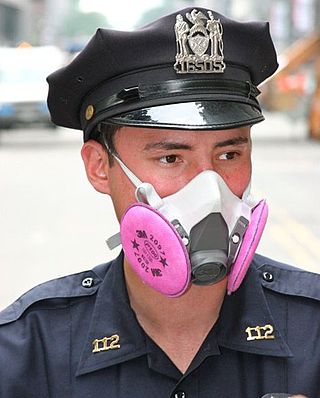
Elastomeric respirators, also called reusable air-purifying respirators, seal to the face with elastomeric material, which may be a natural or synthetic rubber. They are generally reusable. Full-face versions of elastomeric respirators seal better and protect the eyes.
FFP standards refer to the filtering half mask classification by EN 149, a European standard of testing and marking requirements for filtering half masks. FFP standard masks cover the nose, mouth and chin and may have inhalation and/or exhalation valves.
Nicole M. Bouvier is an American physician who is Professor of Medicine at Icahn School of Medicine at Mount Sinai. Her research considers the environmental and viral factors that impact respiratory transmission of influenza viruses.
























